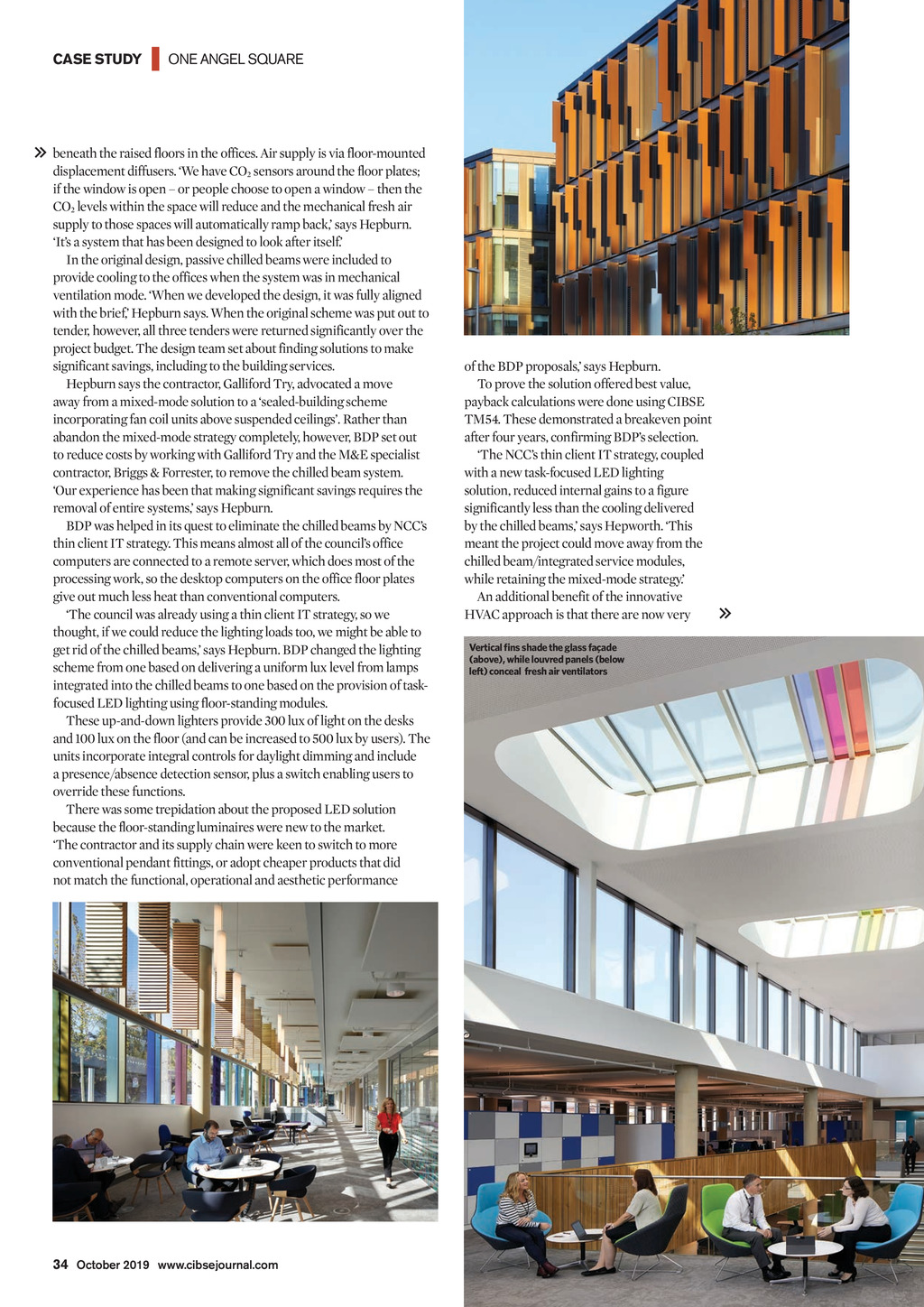




CASE STUDY | ONE ANGEL SQUARE beneath the raised floors in the offices. Air supply is via floor-mounted displacement diffusers. We have CO2 sensors around the floor plates; if the window is open or people choose to open a window then the CO2 levels within the space will reduce and the mechanical fresh air supply to those spaces will automatically ramp back, says Hepburn. Its a system that has been designed to look after itself. In the original design, passive chilled beams were included to provide cooling to the offices when the system was in mechanical ventilation mode. When we developed the design, it was fully aligned with the brief, Hepburn says. When the original scheme was put out to tender, however, all three tenders were returned significantly over the project budget. The design team set about finding solutions to make significant savings, including to the building services. Hepburn says the contractor, Galliford Try, advocated a move away from a mixed-mode solution to a sealed-building scheme incorporating fan coil units above suspended ceilings. Rather than abandon the mixed-mode strategy completely, however, BDP set out to reduce costs by working with Galliford Try and the M&E specialist contractor, Briggs & Forrester, to remove the chilled beam system. Our experience has been that making significant savings requires the removal of entire systems, says Hepburn. BDP was helped in its quest to eliminate the chilled beams by NCCs thin client IT strategy. This means almost all of the councils office computers are connected to a remote server, which does most of the processing work, so the desktop computers on the office floor plates give out much less heat than conventional computers. The council was already using a thin client IT strategy, so we thought, if we could reduce the lighting loads too, we might be able to get rid of the chilled beams, says Hepburn. BDP changed the lighting scheme from one based on delivering a uniform lux level from lamps integrated into the chilled beams to one based on the provision of taskfocused LED lighting using floor-standing modules. These up-and-down lighters provide 300 lux of light on the desks and 100 lux on the floor (and can be increased to 500 lux by users). The units incorporate integral controls for daylight dimming and include a presence/absence detection sensor, plus a switch enabling users to override these functions. There was some trepidation about the proposed LED solution because the floor-standing luminaires were new to the market. The contractor and its supply chain were keen to switch to more conventional pendant fittings, or adopt cheaper products that did not match the functional, operational and aesthetic performance of the BDP proposals, says Hepburn. To prove the solution offered best value, payback calculations were done using CIBSE TM54. These demonstrated a breakeven point after four years, confirming BDPs selection. The NCCs thin client IT strategy, coupled with a new task-focused LED lighting solution, reduced internal gains to a figure significantly less than the cooling delivered by the chilled beams, says Hepworth. This meant the project could move away from the chilled beam/integrated service modules, while retaining the mixed-mode strategy. An additional benefit of the innovative HVAC approach is that there are now very ertical ns shade the glass fa ade (above) while louvred panels (below left) conceal fresh air ventilators 34 October 2019 www.cibsejournal.com CIBSE Oct19 pp32-34, 36 One Angel Square.indd 34 20/09/2019 16:52